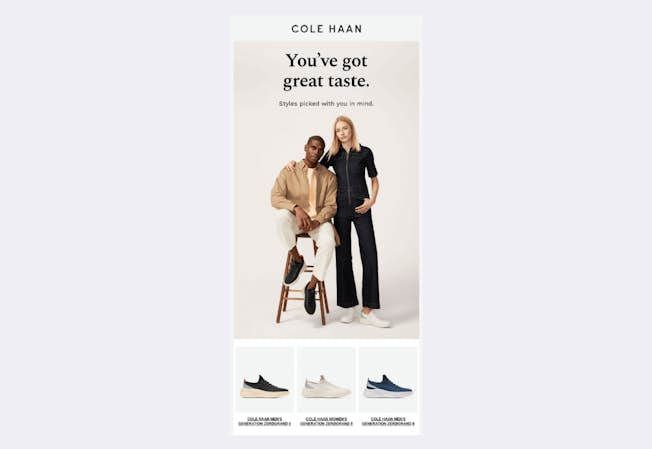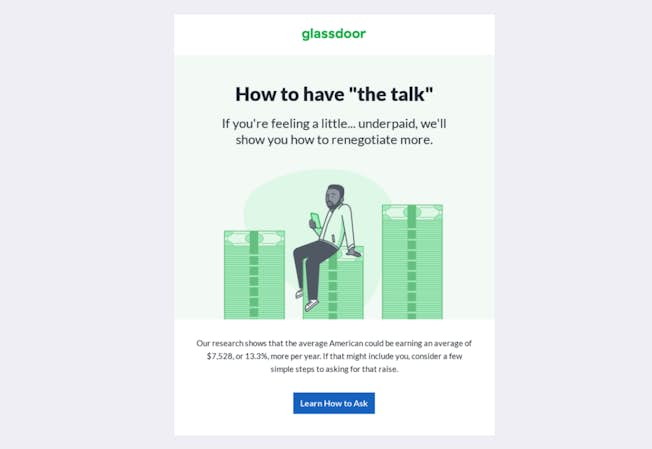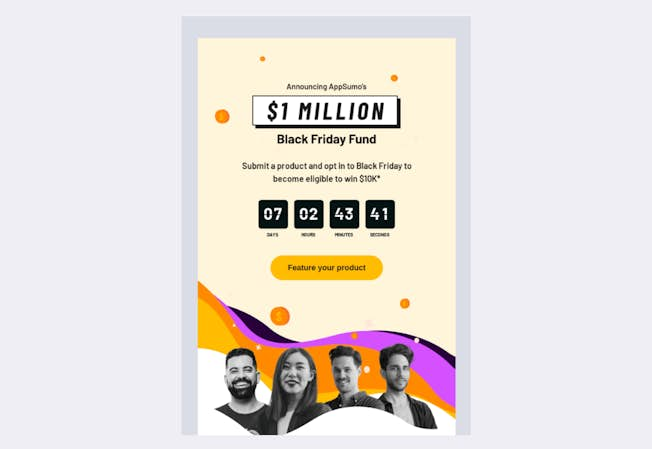There’s no doubt that email marketing is a powerful tool for any marketer. It’s an effective and simple way to nurture leads, retain customers and convert interest into a purchase.
However, with so much content arriving in people’s inboxes on an hourly basis, it can be tough to stand out from the crowd. Anyone can write an email, but there’s an art to writing one that prompts clicks and conversions.
So how do you write a good marketing email? In this blog, we will give you a step-by-step guide to creating an email that appeals to prospects and customers.
Step 1: Align messaging with the correct segment and stage in the funnel
First and foremost, you need to know who you are talking to in your emails. That requires you to develop a buyer persona that gives a profile of your ideal customer/s.
This will guide all of your messaging not only on email but across content. It’s a level of detail about your customer that will enable you to craft emails that are relevant and of interest to the recipient, increasing the chances of engagement and conversion.
Tip: Download our buyer persona template to help you create a picture of the individual customers within your target audience
Once you know who your personas are, you can create messaging that provides solutions to their pain points. For example, let’s say you’re a recruitment agency and your persona is just out of college with no job experience. Content of value to them would be a CV and resume clinic or a meeting with one of your consultants.
In addition, to target the right people with the right message you need to segment your lists.
You can have a master list that can be sent generic messaging such as promotions or special offers. But personalization is crucial in email, so you need to segment lists to target different audiences. Examples are ‘lapsed subscribers’, ‘prospects that purchased X’, or ‘blog leads’.
Step 2: Come up with a powerful subject line
The subject line is the first thing a person will see in their inbox - so make it count. It’s not enough to just add an emoji and add the word ‘NEW’. It needs to be enticing enough for your audience to open it.
Ways to craft the perfect subject line are:
- Keep it short and snappy - Remember a lot of people open emails on their mobile, and content gets cut off at a certain length so keep it to the point.
- Add personalization - This could include adding the person’s first name or the name of a product or course they showed interest in.
- Tell them what’s inside - Try to give a hint as to what content they will get when opening the email, it will prompt interest.
- Take inspiration from successful ones - You probably have emails in your inbox that made you click. Review and analyze them to see what they did right and why you opened them.
- Ask a question - People love to be asked for their opinion so ask a question in your subject line to see how it performs.
- Consider emojis - Emojis are fun and can appeal to an audience. But be careful how you use them and what you use. Make sure they are relevant to the subject line and audience.
- Include action verbs - Using action verbs is more powerful than using a passive voice. So instead of ‘’New podcast on SEO’ write ‘Listen to our new SEO podcast with X’.
- Integrate FOMO - People love to be in the loop, so try to use a subject line that taps into a fear of missing out (FOMO). In other words, if you don't open this, you’ll miss out!
These points are particularly important if you’re writing a cold marketing email as you know very little about your prospect, so crafting a great subject line will help drive open rates.
Tip: Download the 'Email Content and Copywriting Checklist' to get some help in crafting great emails!
Step 3: Personalize the message
A study, ‘The Rise of Personalized Commerce’ found that 70 percent of companies that use advanced personalization earned a 200 percent return on investment from it. That’s because personalization works when done properly.
By using segmentation you can group your email mail list into distinct groups and then craft content that is important or relevant to them. Or be clever about your copy and catch a range of personas like in this email marketing example from Cole Haan. The important thing is that people feel special and you have thought about their needs.

Including a name is the first place to start either in the subject line or in the first line of your email. Nobody wants to read ‘Dear sir’ anymore. You can also personalize based on past purchases. If they bought this type of product, they may be interested in a similar one if you tell them about it.
This also counts for downloadable assets or events such as live webinars. If they downloaded an ebook for example then you could retarget them with a blog, webinar or podcast on the same or similar topic.
Tip: Check out ‘The Anatomy of an Effective Marketing Email’ to see if your emails include what’s required.
Step 4: Establish a relationship with your prospects & customers
The key strength of email is that it allows you to build relationships with your customers and prospects. It allows you to tell them things about your brand or product and service they may not have known otherwise.
Use this opportunity to tell them more about your business or make it more personal. An email from your CEO that talks about the goals or ethics of your business could work well. Or offer VIP access or early bird discounts to your email list before anyone else to show them you care about their interest and commitment.
It’s wise to also use personal language like ‘you’ or ‘your’ to treat them like an important part of your business or even a friend of your brand. This is a great example of using that tactic from Glassdoor.

Step 5: Emphasize the benefits
What you should keep in mind when writing any email is, what are the benefits to the reader? What will the recipient gain from opening and engaging with this email?
If you cannot answer that, you need to start again as it’s a crucial part of any good marketing or prospecting email that gets replies.
There are a few things you should always include to make your email a great one:
- Understand your audience - As we’ve already said, use those personas to make content relevant and interesting
- Use clear and relatable language - Always be consistent in your tone but tweak the language you use based on who you’re talking to. Remember most audiences are global (unless you localize) so try to keep the language simple and accessible.
- Offer value - Don’t just try to sell, offer value to your audience. This can be simply new information about your sector or a free asset such as an ebook or webinar sign-up.
- Be credible - To build trust, you need to prove that you have street cred. It’s always worth drawing attention to customer testimonials or including awards or praise from an accredited body or media. This could simply be a logo or link to a news article.
- Link to something topical or newsworthy - If there’s something in the news that you can leverage, then use it. For example, if you’re a retailer and there’s a buzz around sustainable fashion, promote it to create engagement.
- Have a clear CTA - Always, always include a CTA, in some cases include two if that works for you! Make sure it’s asking your prospect or customer to do something like ‘Find out More’ or ‘Learn How to Ask’.
Step 6: Inspire action
Every email should inspire the person to take action. It doesn’t matter if it’s to read a blog, download a whitepaper or simply check out your website. The goal of your emails is to promote engagement and that means opening and clicking through.
To do that you need to use active language and CTAs that prompt action. Don't be shy about using strong language in your emails to work towards that action. Ultimately, you don't want someone to open it only to decide it’s not for them and bin it.
One tactic to achieve this is to use a countdown for an event such as an upcoming live webinar or social media livestream. You can also ask people to sign up for a newsletter or podcast to keep up with things in your industry.
The example below from daily deals website AppSumo leverages Black Friday and a countdown to encourage engagement.

Step 7: Keep in touch and connected
You should also use your email to keep your business in people’s minds, so make sure they know how to contact you.
Include a valid email address that is monitored by staff to ensure a quick response and promote your social media handles in the header or footer. If you use WhatsApp for customer service, include that as a communication medium.
Inviting people to Facebook groups or a Discord channel will also provide recipients with an opportunity to get involved with your business if they want to. It’s also a great way to build a loyal customer base using email.
Step 8: Test different messages and keep optimizing
The only way to find out if your email content is working is to test it. Sure, you could continue to rehash top-performing content, but that will only work in the short term and it won’t give you any insights into your content or audience.
A/B testing is crucial in your email marketing. The key variables you can test are:
- Subject line - This is simply pitting one subject line against another and seeing which performs better.
- Images - Images used as banners or in your email can slow it down or put people off, so test to see what works for you
- CTAs - Test what you’re asking people to do. Does ‘Buy Now’ work or is ‘Start Your Free Trial’ a better option?
- Content - You need to be careful when testing reams of text but let’s say you include a customer testimonial in the copy, does it perform better?
Tip: Download our ‘A/B Testing Toolkit and Videos’ to get some guidance in the area.
There are a lot of platforms and tools out there to make your life easier when planning and executing email marketing campaigns.
Automation tools can be a lifesaver for a business, especially if you have a busy marketing team or you are relying on one or two marketers to do everything. Here’s a practical guide to the top email marketing automation tools out there.
Artificial Intelligence is also coming to the fore when it comes to writing content. The benefit of AI writing is that it can create content at a rapid pace so it’s useful for companies that need content at scale. Great examples of AI software are Jasper, AI-Writer and WriteSonic.
Just be aware that there’s still some way to go before AI software gets the hang of nuance and creativity.
Tip: Check out ‘What are the Top Content Marketing and SEO trends?’ to see what’s coming down the line in 2023.
Use Your Emails to Inform, Engage and Convert
There are a lot of elements to think about when devising, creating and implementing email marketing campaigns. DMI’s short and comprehensive Email marketing course focuses on email strategy, content creation and time management, creativity and content design along with A/B testing, optimization and automation. Enroll today to get a certification that equips you with the skills to craft effective emails that engage and convert.
Related
Upgrade to Power Membership to continue
your access to thousands of articles, toolkits, podcasts, lessons and much much more.
Become a Power Member- Login
- View Courses
- - - -
- Courses
- Resources
- - - -
- My Account
- Change Password
- Logout





